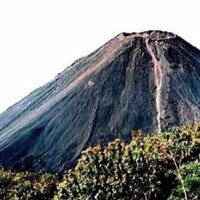
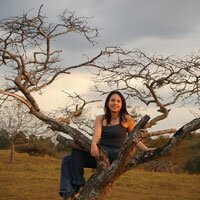
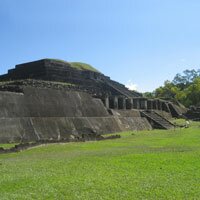
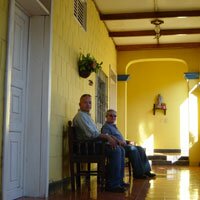


The Nation”s Flag consists of two horizontal blue stripes with a white stripe in the middle of them on a cloth parallelogram the officially measures 3.35 meters long by 1.89 meters wide. The stripes are 0.63 meters wide.
Adopted through a Legislative Decree of May 17, 1912 it is the same Central American Federation flag decreed by the Constituting National Assembly on August 21, 1823. It was sworn at Campo Marte Park on September 15th of the same year 1912 when it was personally raised by the President of the Republic, Dr. Manuel Enrique Araujo.
The Ministry of Education (previously known as Public Instruction) has officially adopted the “Pledge of Allegiance to the Flag” written by Dr. David J. Guzman, which states as follows:
“God save you, Patria Sagrada,
We were born in your heart and loved;
you’re the air that we breathe,
the land that sustains us,
family love,
the freedom that we defend,
religion that we take.
You have our dear home,
fertile countryside
majestic rivers,
magnificent volcanoes
peaceful lakes,
skies of purple and gold.
In your fields undulate golden spikes,
workshops in your vibrating motors,
sizzling the anvils,
the beauty of art emerge.
Patria,
smooth on your tongue
we ask that you protect the Order,
to open our souls to glow in the sky,
recorded in it and sweet affection School Teacher
inspire us and your holy love.
Patria,
your story,
coat of arms of heroes and martyrs,
review virtues and aspirations;
You obeisances Minutes devoted to national sovereignty
and marks the path florida
that justice and freedom lead us to God.
Bandera de la Patria,
sacred symbol of El Salvador,
reverent you greet the new generation!
For you
vivifying sun of our glory,
anthems of patriotism,
the laurels of the hero.
For you
respect for people
and the crown of love
Today ceñimos your temples immortal. “
The allegiance to the National Flag is characterized by a strong devotion because it symbolically expresses our people”s fight for freedom. The ideals for peace, work and progress of the Salvadoran people are sheltered under its pleats and by respecting, loving and learning to defend it, the Country can be lead towards the realization of its historic mission.
The National Flag consists of two horizontal stripes, blue, interposed between them and the other white, in a parallelogram of cloth officially measured 3.35 meters long, 1.89 wide. The stripes have a width of 0.63. Adopted by the Legislative Decree of May 17, 1912, is the same as the Central American Federation, decreed by the National Constituent Assembly on August 21, 1823. Was sworn in at Campo Marte on September 15 of that year, 1912, to be raised personally by the then President of the Republic, Dr. Manuel Enrique Araujo.
The Ministry of Education (formerly of Public Instruction), has officially adopted the “Prayer to the Flag,” by Dr. David J. Guzman, which reads as follows:
“God save you, Patria Sagrada,
We were born in your heart and loved;
you’re the air that we breathe,
the land that sustains us,
family love,
the freedom that we defend,
religion that we take.
You have our dear home,
fertile countryside
majestic rivers,
magnificent volcanoes
peaceful lakes,
skies of purple and gold.
In your fields undulate golden spikes,
workshops in your vibrating motors,
sizzling the anvils,
the beauty of art emerge.
Patria,
smooth on your tongue
we ask that you protect the Order,
to open our souls to glow in the sky,
recorded in it and sweet affection School Teacher
inspire us and your holy love.
Patria,
your story,
coat of arms of heroes and martyrs,
review virtues and aspirations;
You obeisances Minutes devoted to national sovereignty
and marks the path florida
that justice and freedom lead us to God.
Bandera de la Patria,
sacred symbol of El Salvador,
reverent you greet the new generation!
For you
vivifying sun of our glory,
anthems of patriotism,
the laurels of the hero.
For you
respect for people
and the crown of love
Today ceñimos your temples immortal. “
The cult of the flag takes on the character of a supreme devotion. She specifically and symbolically expresses all the liberation struggles of our people. Under its folds have been sheltered to the ideals of peace and progress of the Salvadoran national, and respecting it, learning to love and defend it, can lead to the realization of the Patria to its great historic mission.
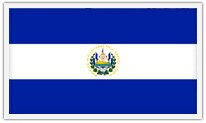
THE NATIONAL COAT OF ARMS CONSISTS OF THE FOLLOWING:
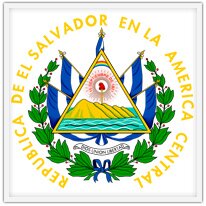
Originates in the Mesoamerican region, which belong to the Central American countries.
Belongs to the family of Liliáceos and the order of Liliflorales, which includes many genera and species.
Among its uses are for ornamental, edible and used to manufacture textiles.

The National Anthem of El Salvador was commonly adopted as the National Song on September 15, 1879 but did not have official recognition until December 11, 1953, as a result of a famous press dispute that arose respecting some doubts. After this dispute was over, another song was officially recognized as the National Anthem.
The Official National Anthem was composed and written by the artist Juan Aberle, Italian composer that arrived in the country at the end of the 18th Century as the Director of an Opera Company and by General Juan José Cañas, an inspired poet and distinguished military that took arms with the National Army against filibusters, around the year 1856. It was composed by recommendation of President Dr. Rafael Zaldívar and was sung for the first time on September 15, 1879 at the prior National Palace by children and young students from government and private schools of the capital city. These students had practiced the Anthem for three months, and when they sang it for the first time that September morning the impression was so splendid: the inspired poet as well as the prestigious composer had succeeded.
CHORUS
HEALTH PATRIA PROUD
CHILD Suyos able CALL;
THE LIFE AND JUREMOS Animo.
NO REST YOUR WELL served.
First Verse
Of peace in the supreme
Always dreamed noble El Salvador;
Was to get their eternal problem
Keep their glory greater.
And with the way faith
Strives for progress to continue
Great for filling your destination
Won a happy future.
It protects a railway barrier
Clash against disloyal to ruin,
From the day that its flag high
Wrote with their blood: Freedom!
Second Verse
Freedom is their dogma, their guide,
Successfully defend a thousand times;
And many others from tyranny bold
Reject the hateful power.
Is painful and bloody history,
But lofty and brilliant at the same time,
Source of self-glory,
Great lesson in Spartan pride.
Ignat their bravery will not stop:
In every man there is an immortal hero,
That he will keep pace
Of their former value proverbial.
Third Verse
All are dedicated and loyal
The prestige of military ardor,
As always segaron laurels
The homeland of saving the honor.
Respect the rights strangers
And based on right reason
For it is not clumsy rigging,
The invariable ambition stronger.
And following this line holds,
Dedicating her tenacious efforts
In stark war to make war;
His fortune is at peace.
(chorus – bis)
Lyrics: José Juan Cañas
Music: John Aberle
José Juan Cañas was born in 1826. He first studied in Nicaragua and later in Guatemala where he obtained his High School Diploma. Went on to the University to study three years of Medicine. In 1848 he returned to El Salvador and later traveled to San Francisco looking for gold. He later traveled to Nicaragua and joined the army that was fighting against the filibuster William Walker.
In Cañas united we see harmony in three personalities: poet, diplomat and military. His literary collection initiated at age 17 includes poetry, literary prose, critic works, narrations and several articles. In poetry he is the originator of Romanticism in El Salvador. His fame as a poet goes beyond our frontiers.
He served in administration posts as Political Governor and Vice Minister of Foreign Affairs. During his diplomatic career he represented El Salvador in Santiago, Chile as Plenipotentiary Minister and achieved the signing of a treaty that strengthened relations between both countries.
He was attributed many literary honors during his life. In 1882 the Colombian Academy in Bogota designated him as foreign honorary member. He was President of the Salvadoran Academy of the Language as part of the Spanish Royal Academy. Numerous artistic organizations welcomed him as a member.
He died on January 19, 1918. His numerous poems figure in the “Central American Poetic Gallery”, in the “Guirnalda Salvadoreña” (”Salvadorn Garland”) and also were published in the newspapers of his time.
The famous poet Ruben Dario called him “The Patriarch of the Central American Poetry” and Jose Marti, “Veteran of the Lyre and the Sword”.
Juan Aberle was of Italian nationality but made of El Salvador his second country when he married a native from the city of Ahuachapan. He was born in the city of Naples, Italy on December 11, 1846.
When he was 11 years old, impelled by his devotion to music, he applied to the Naples Conservatory against his parents” will. There he gained a strong knowledge of music. He later traveled to New York, United States where he was Opera Director for a period of five years.
He decided to go on an artistic tour to the Latin American countries. During his stay in the city of Guatemala, capital city of the Republic of Guatemala, he founded the Music Conservatory in 1879. He came to El Salvador and established the School of Music.
For all his merits, the Government named him Director of the Highest Power Band substituting the German, Carlos Malhamann, who left for the I World War. He gave up this position in 1922 due to his old age. Death came to him on February 28, 1930.
His favorite instrument was the piano. He composed abundant chamber music and made transpositions of opera fragments to be played on piano. His march “Morazan” was declared a national march on May 1, 1882. He wrote two operas: “Ivanhoe” was one of them. He also wrote “Treaty of Harmony, Counterpoint and Fugue”.
This is the concise history of El Salvador”s National Anthem. As supplementary information it is important to know that the authors received no stipend or reward from the Government for their work. It was until 23 years later in 1902 when General Tomas Regalado was President of the Republic that the Legislative Congress agreed to grant each one of them a gold medal, which in a feeling of national gratitude was bestowed to them by the Head of the Nation.
The memory of these great men lives in the conscience of the Salvadoran people.

The government of El Salvador is integrated by an Executive Branch, Legislative Branch and a Judicial Branch. Information on the composition of each Branch is provided as well as their web site to obtain additional information.
The Executive Branch of the government is made up of the President, Vice-President, their Cabinet of Secretaries, a series of Superintendence’s, and the 14 Ministries.
The President is the head of the Executive Branch, aided in turn by a Vice-President. Both are elected by universal suffrage every 5 years. The President cannot be elected for a successive term.
The Executive Branch has 14 ministries. The Ministers are appointed by the President, and remain in office for the duration of the Administration’s term.
The functions and responsibilities of the Executive Branch are in the internal rules of the Executive Branch.
The Legislative Assembly integrates the Legislative Branch. It is integrated by 84 congressmen elected by popular vote and therefore juridically “represent the entire people and are not linked to any dominant authority”. “They have immunity and have no responsibility at any time for the emitted opinions or votes”. Art. 125 of the Constitution of El Salvador, (Cn).
Most frequently asked questions and answers on the Legislative Branch structure.
The Supreme Court of Justice is the highest decision power within the Judicial Branch and is integrated by 15 Magistrates. It is divided in 4 courts: Civil Court, Penal Court, Constitutional Court and Administrative Contentious Court where the magistrates are resourcefully divided.
The Civil and Penal Courts deal with appeal and derogatory resources against the Chamber sentences. The other two courts deal with the constitutional, constitutional guarantee for protection of civil rights, habeas corpus and unconstitutionalities; and the administrative contentious, of the same name resource.
One step below there are the second instance chambers each one integrated by two magistrates that deal with the territorial competence stipulated by law, which are resources of appeal, of fact or review intended against resolutions issued in first instance courts.
Following are the first instance courts. These are personal courts that deal issues and territories stipulated by the respective law. They can be mixed, that is with competence in two or more issues. On the penal side, there are courts for instruction and sentence. These are integrated by three judges.
The judges of peace are the last ones in the judicial hierarchy. These are personal courts that deal with various issues (trade, civil) in cases of fewer amounts. They also develop the first procedures in penal processes and celebrate judicial conciliations.

“In the Name of Almighty God, One and Triune, whose invocation of God is everything good start, good middle and happy end. In the city of Salvador in the world, at half past nine p.m. today’s twenty-first day of September of the year one thousand eight hundred twenty-one, first of our independence and freedom and tax Intendente Mr. Chief Political accidental Dr. D. Pedro Barriere of minutes passed in Guatemala, and in fifteen of the circular flow to these provinces, and upon agreement of all authorities met to declare an actual declared that memorable day the independence of Spanish Government in the terms that are read the minutes and in the manifest with the date circled the Lord High Chief Political D. Gabino Gainza, which sets out the rationale and reasons that the most impulsive exijían imperative as high resolution, agreed that Mr. Mayor and Mr. 1 Mayor D. Casimiro Garcia Valdeavellano, available at that time attended the City Council all individuals, and were called to the military, Mr. Cura Rector and Vicar, the Prelates Regulars, the neighbors of all major classes and Scythian is the whole neighborhood, as was done by ringing of bells, music and fireworks. Verified the reunion, with numerous people, he did understand the cause of rejoicing, it also said in his half of a transport inesplicables, with live demonstrations and plenty of cheers, which esplicaban, as more enérjico, desires jeneralmente were all identified and responsibility for this occurrence, which determines the future happiness.
This statement is provided as a first step, all conducted at the Holy Church, to the mercies of God due thanks, by size advantage. In the temple was launched leyéndose by Codjutor D. Br José Crisanto Salazar expressly literally minutes as sacred monument of our freedom, and this ceremony concluded, the entire contest, prostrate on the ground, gave worship to God Sacrament, was sung in the most solemn Te Deum, and turning to the City consistorial houses between Victor and cheers from the many people who followed him, open the repeated reading of the record cited. Then set up Mr. Political Chief, who presides over the ceremony, Mayor exijió of 1 (as requested by the people) to receive the oath due to operate, and indeed did so solemn God Ntro . Mr Santa Cruz and Santos Evanjelios, save and keep the independence, be faithful to the monarchy and observing the American government and what is established and the laws that sanction. Completed the event in style last f it was agreed that tomorrow at ten individuals were sworn in this City, corporations, employees and clerks, and that you will be issued by side with all the pomp and solemnity possible, the Minutes and circulated manifesto referred by Mr. Superior Political Chief, paving previously with Mr. Colonel, Commander of weapons, for assistance: that is advertised to the public in that band for the day of the current twenty-nine be verified in all solemnity allowing short intermediate time, for the publication and proclamation, and the thirty days are also held solemn Mass of thanksgiving, and receive the oath of the people, all of which was understood to take its provisions, Mr. priest and vicar D. Br José Ignacio Zaldaña, which has been present throughout. It allowed the people, excited joy of relief that he was unable to repress his wishes to see achieved, continue to rejoice in its honesty and restraint for so beautiful and desirable occurrence, and all orders were to keep the precautionary good order. It was also agreed that this book serve as a principle, forming new book estender to the records of National City common role, as if sanctioned, off-court matters, has been the use of stamped paper, containing the current sign dependence of the Spanish domination. Which completed the report, which signed its chairman individuals of this Ayuntamiento.-Barriere-Pedro Casimiro José Ignacio García-Valdeavellano Zaldaña-José Bustos Rosi-Milian-Gerónimo Ajuria Francisco Duque-Rosi-Santiago-Trinidad Estupinian Juan Bautista de Francisco Ignacio de Otondo-Urrutia-Narciso Ortega-By mandate of the Most Noble City: Pedro Miguel Lopez Srio.”

TREE OF EL SALVADORAccording to Legislative Decree N °. 44 September 1, 1939, were designated as the national tree and the Balsam Maquilishuat (Tabebuia rosea), the latter achieved more popular roots in the soul. This tree can measure up to 15 meters in height. Its great and majestic pink flowers, they offer varying degrees of intensity in color. When Maquilishuat blossoms, is one of the most beautiful in the region. Its wood is very thin, making it highly prized for cabinet work, and by its light weight yellow amber with streaks glitter. It also has medicinal properties too little explored.  NATIONAL AVEIt was declared national bird by Legislative Agreement on October 21, 1999. The torogoz or talapo received this honor due to its unique beauty, in its polychrome plumage. Unadaptable bird is a captive and a symbol of family unity, participation by children in the care of their chicks. Although it is an endangered species, still found in mountainous areas of the northeastern region of the country, as Morazán, northern Chalatenango and La Unión.  |
The mission of CEA is to increase awareness of Salvadoran Culture & History within our local & international community. CEA will accomplish the awareness by providing Cultural & Educational services in our communities, both local and international.